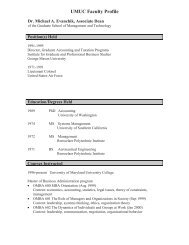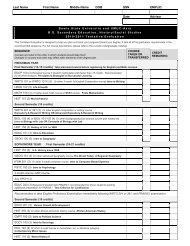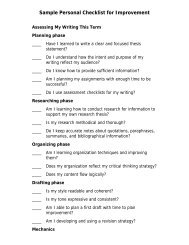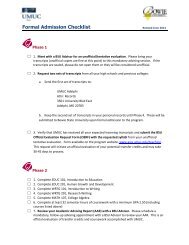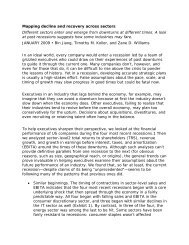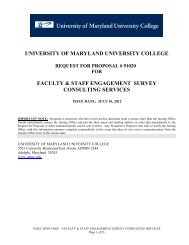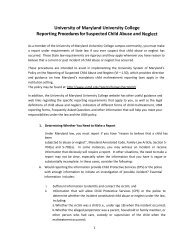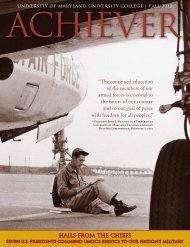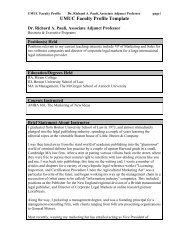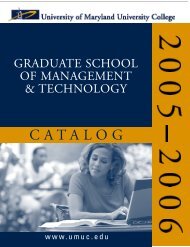1a. IntroSUS 2003 - University of Maryland University College
1a. IntroSUS 2003 - University of Maryland University College
1a. IntroSUS 2003 - University of Maryland University College
- No tags were found...
You also want an ePaper? Increase the reach of your titles
YUMPU automatically turns print PDFs into web optimized ePapers that Google loves.
ARTT 458 Graphic Design andIllustration (3)An introduction to the basic elements <strong>of</strong> design. Projects focus onproblems central to the commercial arts. Basic skills with a variety<strong>of</strong> media and techniques are developed.ARTT 468 Seminar: InterrelationshipBetween Art and Art Theory (3)An exploration <strong>of</strong> the relationship between a student’s work andthe theoretical context <strong>of</strong> contemporary art. May be repeated to amaximum <strong>of</strong> 6 credits when topics differ.ARTT 470 Watercolor (3)An opportunity for further development <strong>of</strong> painting in watercolorsat beginning or advanced levels. May be repeated to a maximum<strong>of</strong> 6 combined credits in ARTT 470 and ARTT 489B.ARTT 479 Advanced Computer Graphics (3)Prerequisite: ARTT 354. A study <strong>of</strong> advanced techniques in andthe theory behind computer imaging, graphics, illustration, andmixed media. Projects require six hours <strong>of</strong> computer work perweek, some <strong>of</strong> which must be completed independently.ARTT 486A Internship in Art ThroughCo-op (3)Prerequisite: Formal admission to the Co-op program (programrequirements are listed on p. 18). An opportunity to combineacademic theory with new, career-related experience in art. Atleast 12 hours per week must be devoted to new tasks for a minimum<strong>of</strong> 180 hours during the Co-op session; four new tasksmust be delineated in the Learning Proposal; and the course requirementsmust be completed. May be repeated upon approval<strong>of</strong> a new Learning Proposal that demonstrates new tasks and objectivesrelated to art and that continues to advance application<strong>of</strong> academic theory in the workplace. Students may earn up to15 semester hours in all internship coursework through Co-optoward a first bachelor’s degree and up to 9 semester hours towarda second bachelor’s degree. Co-op credits may not be used forgeneral education requirements and, unless otherwise specified,no more than 6 Co-op credits may be used in the academic majorand minor (combined).ARTT 486B Internship in Art ThroughCo-op (6)Prerequisite: Formal admission to the Co-op program (programrequirements are listed on p. 18). An opportunity to combineacademic theory with new, career-related experience in art. Atleast 20 hours per week must be devoted to new tasks for a total<strong>of</strong> 300 hours during the Co-op session; five to eight new tasksmust be delineated in the Learning Proposal; and the course requirementsmust be completed. May be repeated upon approval<strong>of</strong> a new Learning Proposal that demonstrates new tasks and objectivesrelated to art and that continues to advance application<strong>of</strong> academic theory in the workplace. Students may earn up to15 semester hours in all internship coursework through Co-optoward a first bachelor’s degree and up to 9 semester hours towarda second bachelor’s degree. Co-op credits may not be used forgeneral education requirements and, unless otherwise specified,no more than 6 Co-op credits may be used in the academic majorand minor (combined).ARTT 489 Special Problems in StudioArt (1–3)May be repeated to a maximum <strong>of</strong> 6 credits.ARTT 489E Introduction to Montage (1)(No previous experience necessary.) An intensive, hands-on workshopexploring the many possibilities for using photocopies orother printed materials in making a composite or montage type <strong>of</strong>collage. Step-by-step procedures for making pictures are demonstrated.Some supplies and photocopies <strong>of</strong> research material invarious subjects or themes are available.ARTT 489F Drawing on Both Sides <strong>of</strong> theBrain: Eye/Hand Coordination (1)An intensive drawing workshop focusing on the interrelationshipbetween the left and right sides <strong>of</strong> the brain and between handand eye. A variety <strong>of</strong> drawing approaches are used to provideinsight into the difficulties encountered at all levels <strong>of</strong> experience,thereby freeing individual potential. Studio work is supplementedby demonstrations, visual examples, and use <strong>of</strong> live model andstill-life elements. Aspects <strong>of</strong> works by Edwards, Nicholaides, andBridgeman are examined.ARTT 498 Directed Studies in Art (2–3)(For advanced students.) May be repeated to a maximum <strong>of</strong>6 credits when topics differ.113





